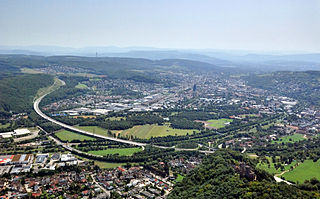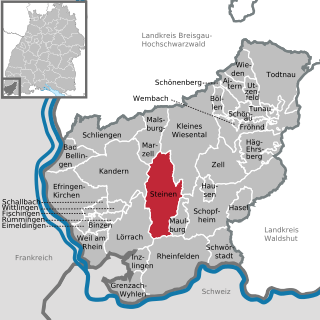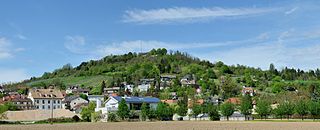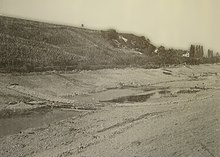Lörrach is a Landkreis (district) in the southwest of Baden-Württemberg, Germany. Neighboring districts are Breisgau-Hochschwarzwald and Waldshut. To the west it borders the French département Haut-Rhin; to the south the Swiss cantons Basel-Stadt, Basel-Landschaft and Aargau.

Lörrach is a city in southwest Germany, in the valley of the Wiese, close to the French and the Swiss borders. It is the district seat of the district of Lörrach in Baden-Württemberg. It is the home of a number of large employers, including the Milka chocolate factory owned by Mondelez International. The city population has grown over the last century, with only 10,794 in 1905, it has now increased its population over 50,000.
The Rhine knee or Rhine's knee is the name of several distinctive bends in the course of the river Rhine.

Hausen im Wiesental is a village in the Lörrach district of Baden-Württemberg, Germany. It is famous for the dialectal poet Johann Peter Hebel who lived in Hausen for many years. The eminent expressionistic painter August Babberger was born in Hausen in 1885. The first historic mention of Hausen was in 1362.

Steinen is a municipality in the district of Lörrach in the southwest of Baden-Württemberg, Germany. It is situated on the river Wiese, 15 km northeast of Basel, and 6 km northeast of Lörrach.

Feldberg is a municipality in the district of Breisgau-Hochschwarzwald in Baden-Württemberg in southern Germany. It is located near the Feldberg, the highest summit in Baden-Württemberg. It comprises the settlements of Altglashütten, Neuglashütten, Falkau, Bärental, and Feldberg. At an elevation of 1,277 m, the last is considered the highest village in Germany.

Zell im Wiesental is a town in the district of Lörrach in Baden-Württemberg, Germany. It is situated in the Black Forest, on the river Wiese, 26 km northeast of Basel, and 32 km south of Freiburg.

Rötteln Castle, located above the Lörrach suburb of Haagen, lies in the extreme southwest corner of the German state of Baden-Württemberg, just 10 kilometres north-east of the Swiss City of Basel. The fortification was one of the most powerful in the southwest, and today, it is the third largest castle ruin in Baden.
The Wiese Valley Railway is a 27.2 km long, electrified main line in German Baden-Württemberg in the tri-national area of Germany, Switzerland and France near the Swiss city of Basel. It is part of the Basel trinational S-Bahn and referenced as S6. It runs alongside the river Wiese from Basel Badischer Bahnhof in Basel to Zell (Wiesental). It is operated by the Swiss Federal Railways (SBB CFF FFS)

The Weil am Rhine–Lörrach railway, also known as the Gartenbahn, is a 4.836 km long electrified, single-track main line railway in the German state of Baden-Württemberg, near Basel. It runs from Weil am Rhein on the Rhine Valley Railway through Tüllinger Berg to Lörrach-Stetten on the Wiese Valley Railway. The continuation of the former bypass of Switzerland was the now disused Wehra Valley Railway from a branch near Schopfheim on the Wiese Valley Railway to Bad Säckingen on the High Rhine Railway (Hochrheinbahn).

The Southern Black Forest Nature Park is located in Baden-Württemberg in Germany and covers an area of 394,000 hectares. As of 2018, it is Germany's largest nature park.

The Dinkelberg is a partially forested hill range, up to 536.2 m above sea level (NHN), about 145 km2 in area, in the High Rhine region of Germany. It lies within the counties of Lörrach and Waldshut in the German state of Baden-Württemberg and the Swiss canton of Basel-Stadt. It is on the southwestern edge of the
Tüllingen is a part of Lörrach, Baden-Württemberg, Germany. It is located on Tüllinger Mountain, which is also known as Tüllinger Hill or simply the Tüllinger. Upper and Lower Tüllingen were merged into the Tüllingen district in 1935.

Weil am Rhein station is a small railway junction in Weil am Rhein in the German state of Baden-Württemberg on the German-Swiss border. The Weil am Rhein–Lörrach railway branches off the Mannheim–Karlsruhe–Basel railway at the station. From 1878 to 1937, the station was the starting point of the Weil am Rhein–Saint-Louis line to the French town of Saint-Louis.

Zell (Wiesental) station is the only station in Zell im Wiesental in the German state of Baden-Württemberg and the terminus of the Wiese Valley Railway (Wiesentalbahn), which runs from Basel Badischer Bahnhof. Since the summer of 2003, Zell station has been served only by the Basel Regional S-Bahn.

The Wiesental, named after the river Wiese, is a valley in the Southern Black Forest. The Wiese is a right-hand tributary of the Rhine which has its source in Feldberg and flows into the Rhine in Basel, Switzerland. The Wiesental was one of the first industrialized regions of the former grand dutchy of Baden and an important production location for the textile industry.

Lörrach-Stetten station is a railway station in the municipality of Lörrach, in Baden-Württemberg, Germany. It is located at the junction of the standard gauge Weil am Rhein–Lörrach line and Wiese Valley Railway of Deutsche Bahn.

Lörrach-Haagen/Messe station is a railway station in the municipality of Lörrach, in Baden-Württemberg, Germany. It is located on standard gauge Wiese Valley Railway of Deutsche Bahn.

Maulburg station is a railway station in the municipality of Maulburg, in Baden-Württemberg, Germany. It is located on standard gauge Wiese Valley Railway of Deutsche Bahn.

The Tüllinger Berg short form Tüllinger, also known as Tüllinger Hügel in Switzerland, is a partly forested mountain located at an elevation of 460.2 m above sea level. It is situated in the southwest of Baden-Württemberg, at the border triangle of Germany, France, and Switzerland. The mountain extends about two kilometers from east to west and about five kilometers from north to south, forming a natural border between the urban areas of Lörrach and Weil am Rhein. Notably, the Tüllinger Berg is characterized by the break-off edge of the high strand of the Rhine Valley and the meadow floodplain. The slope of the Tüllinger Berg, especially with its western mountain nose, defines the surrounding landscape. The border between Germany and Switzerland runs along the southeastern foothills of the mountain.






























